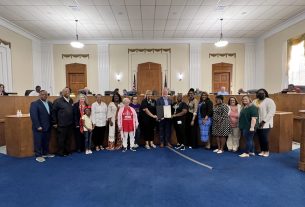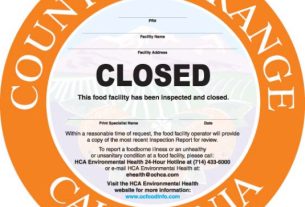[ad_1]
BATTLE CREEK — Marcus Glass couldn’t help but tear up a little bit Thursday morning on his drive to Battle Creek Central High School.
The 1991 BCCHS graduate, now a medical laboratory scientist with Bronson Healthcare, was eager to speak with students about his journey in health care as a Black man. But the emotions tugged at him once he started talking.
“Sometimes you don’t believe you can do it unless you see it,” Glass said. “What was fortunate for me was that I didn’t necessarily, growing up, have folks that looked like me, but I had people that invested in me, that helped me.”
Recognizing that women and minorities are historically underrepresented in health care professions, Glass and other health care professionals from Bronson took to the stage of the McQuiston Learning Center inside Battle Creek Central Thursday to engage in a panel discussion with students dubbed “Imagine Me.”
Panelists discussed their varying paths in health care and their passion for their respective jobs. They fielded questions from students about the profession while also encouraging students to pursue their own dreams during the nearly 90-minute event.
“I think it’s very important for Black and brown children, adolescents to see someone like me in the community to help them understand that this can be for you as well,” Dr. Sylvia Hicks-Fox, a Bronson pediatrician, said.
Elishae Johnson, a licensed professional counselor and system director of business health services at Bronson, graduated from Battle Creek Central in 1999 and currently serves on the Battle Creek Public Schools Board of Education.
If nothing else, she wants students to know they can make an impact in their own community post graduation.
“I know that a lot of times people hear, ‘You might have to leave to get better opportunities,'” Johnson said. “I want our youth here to know that there are opportunities here and that Battle Creek Public Schools really does produce some really amazing talent right here.
“There’s a lot of disparities in terms of Black and brown individuals who go into our field. I really want (students) to wrap their heads around approaching mental health careers and see this as an opportunity.”
Cultivating a pipeline
Ja’Nyah Stewart had no clue what career she wanted to pursue when she first got to Battle Creek Central.
She figured she’d give health care a shot. While the first year of classes was difficult, she’s been able to get a real taste for different health care occupations on-site using the school’s Health Care Simulation Lab. She now aspires to be a neurosurgeon.
“It’s a true learning experience just being in here and knowing that when you step through the door, I’m not Ja’Nyah Stewart, I’m Dr. Ja’Nyah Stewart, that future neurosurgeon that I aim so hard to be,” the senior said. “I really enjoy it here and I would definitely recommend it for anybody.”
The facility, which opened in the fall of 2020, features an array of stretchers, tables and lifts, a replica of an ambulance and even “practice patients” in the form of fully articulated mannequins.
Kellogg Community College and Grand Valley State University offer dual-enrollment courses on-site, in addition to health occupations and nursing courses led by BCCHS staff.
“I’m thinking the majority of high schools should have something like this, but it’s not normal,” said Kaijehl Williams, a senior at BCCHS.
Williams also aims to pursue a career in health care, with interest in becoming either an orthopedic surgeon or neurosurgeon.
“I’m grateful for (the sim lab), it’s given me a head start,” Williams said. “All of these opportunities I’m grateful for, and I’m just taking advantage of them because why not (do it)?”
Using equipment in the sim lab, students learn how to take a patient’s vital signs and how to properly transport or feed patients, among other skills.
BCCHS health occupations and nursing instructor Deana Waterman said the sim lab is “all about exposing and training future health care providers.”
“If you already know you want to go into health care like I did when I was 15, we are getting you the training in high school,” Waterman told the Enquirer in May. “If you’re not really sure, you can still get exposed and then you can (decide), ‘Yes, I think I want to go on in this,’ or, ‘No, I definitely don’t want to do that,’ versus getting out of high school and ending up with student loan debt for something you don’t want to do.”
Hope for the future
A 2019 report by the Association of American Medical Colleges found that 56.2% of physicians in the United States are white, 17.1% are Asian, 5.8% are Hispanic, 5% are Black, and 0.3% are American Indian or Alaska Native.
The number of Black, Hispanic and female applicants and enrollees continued to increase at U.S. medical schools during the 2022-23 academic year.
“To see the talent that’s here (in Battle Creek) is motivating for me,” Bronson Healthcare President/CEO Bill Manns said shortly after touring the sim lab and speaking to students Thursday. “These young men and women really have bright futures. The quality of the questions that were asked was amazing. Having seen the simulation lab, what they have access to and listening to their stories and aspirations and dreams really gave me hope for the future.”
Bronson’s CEO said Battle Creek’s sim lab is comparable to other simulation labs he’s seen in medical schools. To have that opportunity for hands-on learning at the high school level, he said, is incredibly special.
“Being in health care, I look at the pipeline,” Manns said. “When you see what’s happening here in this high school and how prepared these students will be for the future jobs, it makes me smile.”
Before embarking on the path that ultimately led him to become Bronson’s president/CEO, Manns thought he would be a physician. A college internship ultimately shifted his sights toward health care administration, a story he shared Thursday as a reminder to students that “you can pivot and still be successful.”
“If I can have a small role in helping someone along the way, then I’m happy to be here,” Manns said. “For these students to see leaders of color up on that stage, I think it means an awful lot.”
Contact reporter Greyson Steele at gsteele@battlecreekenquirer.com
[ad_2]
Source link


